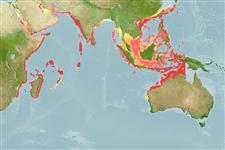Environment: milieu / climate zone / Mức độ sâu / distribution range
Sinh thái học
Biển Cùng sống ở rạn san hô; Mức độ sâu 1 - 110 m (Ref. 89707). Tropical; 30°N - 27°S, 33°E - 136°E
Indian Ocean: Persian Gulf to southern Mozambique and eastward to Western Australia. Not known from the Red Sea.
Length at first maturity / Bộ gần gũi / Khối lượng (Trọng lượng) / Age
Chín muồi sinh dục: Lm ? range ? - 50 cm
Max length : 100.0 cm TL con đực/không giới tính; (Ref. 5222); common length : 75.0 cm TL con đực/không giới tính; (Ref. 5450); Khối lượng cực đại được công bố: 9.0 kg (Ref. 3132)
Các tia vây lưng cứng (tổng cộng) : 11; Các vây lưng mềm (tổng cộng) : 15 - 17; Tia cứng vây hậu môn: 3; Tia mềm vây hậu môn: 8. Distinguished by the following characteristics: color is dark purplish gray with scattered irregular whitish spots and blotches which are faint or absent in preserved fish; ctenoid body scales except cycloid dorsoanteriorly below anterior half of spinous dorsal fin, thorax, abdomen and above anterior anal fin; body with numerous auxiliary scales; greatest depth of body 2.5-3.0 in SL; slightly emarginate to truncate caudal fin; short pelvic fins, 1.7-2.3 in head length (Ref. 90102); head length 2.4-2.7 times in SL; distinctly convex interorbital, slightly convex dorsal head profile; subangular preopercle, shallow notch just above the angle, serrae at angle not or slightly enlarged; upper edge of operculum straight; posterior nostrils of adults is twice the size of anterior nostrils; maxilla reaches vertical at rear edge of eye or thereabouts; ventral edge of maxilla of adults with distinct step distally; 2 rows of teeth on midlateral part of lower jaw (Ref. 89707).
Body shape (shape guide): fusiform / normal; Cross section: oval.
Inhabit clear to turbid water in shallow as well as deep water (Ref. 4787). Juveniles are found in inshore coral reefs (Ref. 5222). They feed in water to more than 100 m depth (Ref. 27275). It has been suggested that juveniles mimic the herbivorous damselfish Neopomacentrus sindensis, presumably to get closer to their unsuspecting prey (Ref. 5222, 9710). Feed on small fishes and crabs. Probably spawn during restricted periods and form aggregations when doing so (Ref. 27352). Eggs and early larvae are probably pelagic (Ref. 6390). Solitary (Ref 90102).
Rock cod are protogynous hermaphrodites.
Heemstra, P.C. and J.E. Randall, 1993. FAO Species Catalogue. Vol. 16. Groupers of the world (family Serranidae, subfamily Epinephelinae). An annotated and illustrated catalogue of the grouper, rockcod, hind, coral grouper and lyretail species known to date. Rome: FAO. FAO Fish. Synop. 125(16):382 p. (Ref. 5222)
IUCN Red List Status (Ref. 130435: Version 2024-2)
Threat to humans
Harmless
Human uses
Các nghề cá: Tính thương mại
Các công cụ
Special reports
Download XML
Các nguồn internet
Estimates based on models
Preferred temperature (Tài liệu tham khảo
123201): 24.7 - 29.2, mean 27.3 °C (based on 386 cells).
Phylogenetic diversity index (Tài liệu tham khảo
82804): PD
50 = 0.5000 [Uniqueness, from 0.5 = low to 2.0 = high].
Bayesian length-weight: a=0.00977 (0.00574 - 0.01664), b=3.00 (2.86 - 3.14), in cm total length, based on LWR estimates for this species & Genus-body shape (Ref.
93245).
Mức dinh dưỡng (Tài liệu tham khảo
69278): 3.9 ±0.66 se; based on food items.
Generation time: 4.1 ( na - na) years. Estimated as median ln(3)/K based on 2
growth studies.
Thích nghi nhanh (Tài liệu tham khảo
120179): Trung bình, thời gian nhân đôi của chủng quần tối thiểu là 1.4 - 4.4 năm (K=0.27).
Prior r = 0.57, 95% CL = 0.37 - 0.85, Based on 1 data-limited stock assessment.
Fishing Vulnerability (Ref.
59153): Moderate vulnerability (39 of 100).
🛈
Climate Vulnerability (Ref.
125649): Very high vulnerability (82 of 100).
🛈
Nutrients (Ref.
124155): Calcium = 19.7 [9.8, 42.9] mg/100g; Iron = 0.456 [0.240, 0.931] mg/100g; Protein = 18.7 [17.2, 20.1] %; Omega3 = 0.12 [0.07, 0.19] g/100g; Selenium = 48.1 [27.5, 89.1] μg/100g; VitaminA = 106 [30, 362] μg/100g; Zinc = 1.01 [0.71, 1.45] mg/100g (wet weight);
